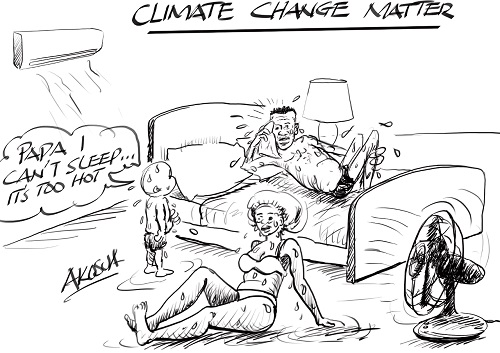
Climate change poses a multifaceted risk that adversely impacts every aspect of human existence, and poses danger to animals, forest reserves, the environment, and business operations.
It is devastating because these risks are interrelated, and point to the fact that challenges in one area can have multiple effects on human rights, social justice, and economic development among others. An example is the spillage of industrial waste, which can affect air pollution, water pollution, food safety and security, etc.
The world is saddled with emerging global megatrend issues: human security, socially responsible stewardship, and environmental and climate change. These patterns in the macro environment are likely to have substantial adverse impacts in the foreseeable future, especially in health, resource scarcity, supply chain, production and consumption, environmental stresses, etc.
Climate governance therefore plays a pivotal role in addressing major complicated issues of climate concerns. A climate governance framework primarily relies on diplomacy, standardized mechanisms, and response measures to navigate social systems. The overall objective is focused on the pillars of climate governance namely mitigation, adaptation, finance, technology and innovation, equity and climate justice, and transparency and accountability.
Internationally, the existing climate governance architecture focuses more on mitigation and adaptation measures that seek to reverse the current negative trend. The framework gives a better understanding of the principal strategies required to address climate change and its related forms of inequality. Climate change poses a threat and necessitates an urgent redesign of the climate governance structure which will comprehensively advance climate justice.
In a fascinating manner, expanded interventions are designed around the pillars of mitigative strategies including reorientation and decoupling. Another pillar is stabilizing strategies that limit exposure to harm with a focus on greenhouse restoration and climate management. The final pillar is adaptive strategies that deal with adjustments and responses to climatic changes and impacts, including resilience and restitution.
Subsequently, this article attempts to highlight the six (6) pillars of climate governance – mitigation, adaptation, finance, technology and innovation, equity and climate justice, and transparency and accountability. This spectrum approach is a requisite to improve climate governance and justice. Embedded in these pillars are clearly defined methodologies on how they operate and descriptive plans underpinning the nuances of tackling climate governance concerns.
Mitigation: The world is already confronted with the effects of climate change, emissions from human activities (electricity, agriculture, transportation, lifestyle, industry, etc.) are a major contributor towards global warming. Regardless, one key avenue of addressing the Greenhouse Gas (GHG) Emissions effect is through mitigation policies and practices. There is also the need to decrease the amount of emissions released into the atmosphere. The carbon concentration in the atmosphere can be reduced by enhancing sinks and imposing taxes on industry players whose activities and business operations pollute the atmosphere and the community.
Adaptation: There is a need to quickly adjust to the effects of climate change. Such an intervention will help avoid or minimize adverse harm to people, the planet, etc. Adaptation measures must be specific actions that are likely to reduce vulnerabilities to the ecosystems. It is the expectation that attention is placed on changes in weather and rainfall patterns, wildlife conservation, marine protection, biodiversity loss, sea-level rise, food production and food security (climate-resilient crops, irrigation system, etc.), and water management among others. It will be crucial to develop, design, and implement a robust mechanism against the impacts of climate change by investing in infrastructure, disaster preparedness, community engagements, and locally-led adaptation systems including behavioural change patterns.
Finance: Climate financing generates a huge debate among stakeholders in the climate environment from the public and private sectors. Financial resources such as aid, loans, grants, or national budget allocations are needed to address climate concerns immediately. They are essential for countries to mitigate climate risks and safeguard livelihoods, especially upholding climate justice and human rights. Some countries are vulnerable and are impacted by conflict, instability, and climate shocks. Such countries require resource allocation to tackle potential climate harm. Resources must be mobilized locally and internationally to fund climate action. Developed countries, organizations like the Conference of Parties (COP), the United Nations, IMF, World Bank, multilateral development banks, and other development partners including research institutions are expected to support developing countries through mechanisms like the Green Climate Fund and technical assistance in implementing climate action policies. Corporate bodies must all be encouraged to put in measures to protect their investments, especially within areas they have their footprints. They can assist through investment in renewal energy, payment for ecosystem services, green bonds, Corporate Social Responsibility (CSR) interventions, nature-based solutions (NBS), and other, community-based projects.
Technology and Innovation: The world is evolving, and with the advancement of technology, it is important to leverage technology in developing climate-friendly interventions to accelerate the attainment of climate strategies. Such climate technologies cover a variety of tools and innovations designed to mitigate the impacts of climate change, improve resilience, and drive sustainable growth. These ideas are dominant in renewable energy systems, reducing industrial carbon emissions, irrigation systems, carbon capture and storage (CCS), and climate-smart agriculture. Generally, climate stakeholders need to develop policy frameworks for climate technology. It will be ideal to strengthen collaboration for Public-Private Partnerships (PPPs) at all levels of engagement to scale up climate technologies. Again, one critical role is the localization and transfer of knowledge, and also adapting global innovations to local contexts and implementation. Climate risks continue to escalate at alarming rates, it is therefore important to use climate technology and innovation to identify new opportunities for sustainable development. However, we need to be mindful that the success of climate technology depends on robust governance frameworks.
Equity and Climate Justice: Interestingly, equity and climate justice are critical aspects of climate governance. In Ghana for example there are deep-rooted inequalities and economic disparities at all levels of nation-building. In designing a climate governance framework, it is important to consider such disparities in helping to shape climate policy and technology adoption. The National Development Planning Commission (NDPC), and Environmental Protection Authority (EPA) have historical data that can be useful in drafting a climate justice policy. Some key areas to consider may include ensuring climate policies do not disproportionately affect vulnerable populations but rather integrate human rights and social justice into governance. Policy implementers must ensure that vulnerable communities are not left behind in the implementation process, and this should include; transition to the use of renewable energy, access to climate technology, climate finance, fair and equitable distribution of climate resources, etc.
Transparency and Accountability: Climate transparency and accountability are key pillars to ensuring climate strategies, funding, and technological innovations tackle climate change positively. However, corruption and inefficiencies are major setbacks in implementing climate governance. Strengthening climate policies through monitoring, reporting, and verification (MRV) systems to track progress and hold actors accountable is essential to attract more funding and other needed support. Access to data by investors, communities, researchers, regulators, policy and decision-makers plays a vital role in sustaining continuity. Investors and funding agencies are interested in monitoring and evaluating the effectiveness of their investments. Rating and scoring mechanisms must therefore be deployed to ensure the fairness and accuracy of the data gathered and how they are impacting positively. This approach helps in establishing sustainability metrics, community acceptance, measuring the risks, and opportunities, providing data for financial analysis, tracking climate commitment, and policy progress, and ascertaining climate vulnerability.
Chiefly, climate governance is critical in addressing climate change complexities. In Ghana and Sub-Saharan Africa, policy implementation, equity, and adaptation to technology and innovation is paramount. A climate governance framework must underpin transparent and accountable governance and also ensure that climate policies are not only well-designed but also effectively enforced at all levels.
Compliance is important in establishing a firm climate governance architecture, in instances where people and institutions decide not to adhere to such regulations, there must be severe sanctions including the suspension and revocation of licenses, fines, imprisonments, etc. Above all, incorporating climate governance values helps create comprehensive solutions that prioritize the needs of vulnerable and marginalized communities.
Moving forward, apart from strong leadership. effective stakeholder collaboration is required, as well as the strengthening of policy, and the leveraging of digital tools for better transparency and accountability. Preferably, broader international stakeholder engagement and participation are necessary to properly align the needs of vulnerable and marginalized groups with the overall objectives of tackling climate change and financing mechanisms.
Finally, in building resilience for the future, international cooperation, networking with funding partners and community-driven engagements will be vital to ensuring that climate governance leads to lasting solutions. Historically, traditional ecological knowledge and practices have been useful in addressing community needs which can be traced back into centuries. Integrating them with modern climate technologies for sustainable solutions is an untapped area worth considering. Climate change impacts communities and their livelihoods, especially through the activities of government and businesses, continuous advocacy and awareness creation for compensation for such communities will be the right call.
Source: Bright Ampadu Okyere – (Business Continuity Coordinator), Bank of Africa, A Climate Change, Sustainability, SDG and ESG Advocate
Email: [email protected] [email protected]
Twitter: @BaOkyere @GhanaSdg
Facebook: Bright Ampadu Okyere (Sabaah)
LinkedIn: Bright Ampadu Okyere
Tel. #: 0244204664
The post Addressing climate challenges through the pillars of climate governance first appeared on 3News.
Read Full Story















Facebook
Twitter
Pinterest
Instagram
Google+
YouTube
LinkedIn
RSS